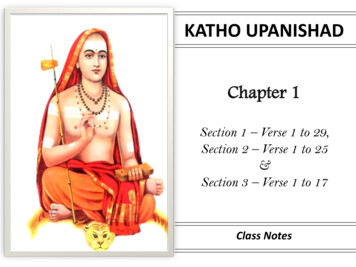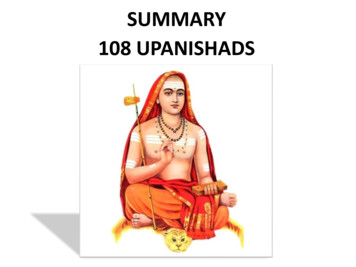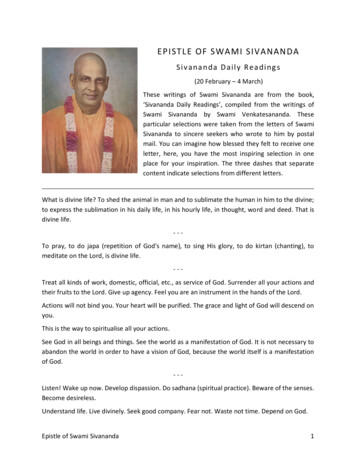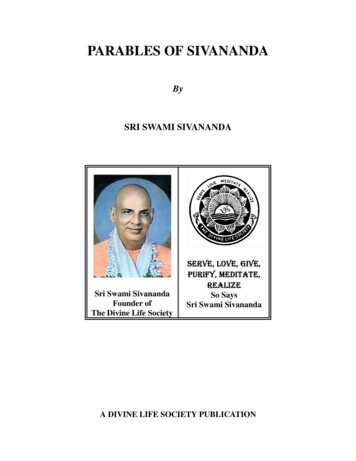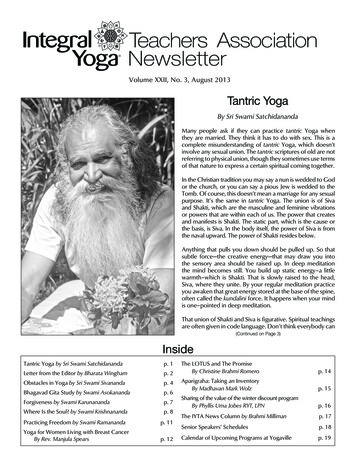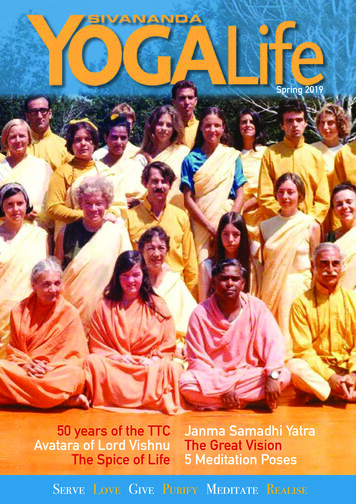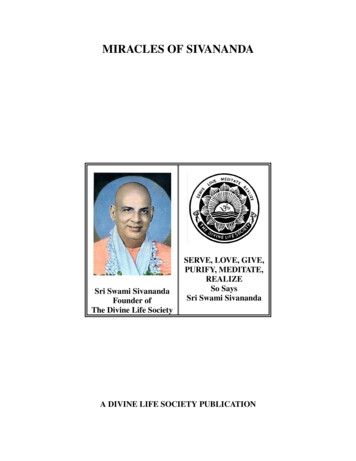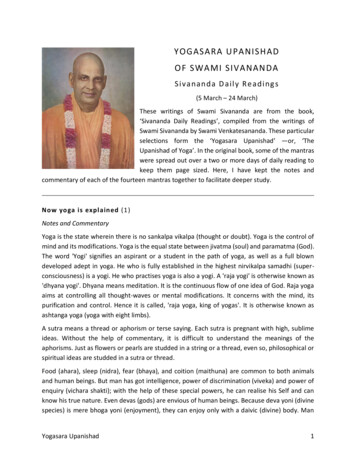
Transcription
YOGASARA U PANISHADOF SWAMI SI VANANDAS i v a na n da D a i l y R e a di ng s(5 March – 24 March)These writings of Swami Sivananda are from the book,‘Sivananda Daily Readings’, compiled from the writings ofSwami Sivananda by Swami Venkatesananda. These particularselections form the ‘Yogasara Upanishad’ —or, ‘TheUpanishad of Yoga’. In the original book, some of the mantraswere spread out over a two or more days of daily reading tokeep them page sized. Here, I have kept the notes andcommentary of each of the fourteen mantras together to facilitate deeper study.Now yoga is explained (1)Notes and CommentaryYoga is the state wherein there is no sankalpa vikalpa (thought or doubt). Yoga is the control ofmind and its modifications. Yoga is the equal state between jivatma (soul) and paramatma (God).The word 'Yogi' signifies an aspirant or a student in the path of yoga, as well as a full blowndeveloped adept in yoga. He who is fully established in the highest nirvikalpa samadhi (superconsciousness) is a yogi. He who practises yoga is also a yogi. A 'raja yogi' is otherwise known as'dhyana yogi'. Dhyana means meditation. It is the continuous flow of one idea of God. Raja yogaaims at controlling all thought-waves or mental modifications. It concerns with the mind, itspurification and control. Hence it is called, 'raja yoga, king of yogas'. It is otherwise known asashtanga yoga (yoga with eight limbs).A sutra means a thread or aphorism or terse saying. Each sutra is pregnant with high, sublimeideas. Without the help of commentary, it is difficult to understand the meanings of theaphorisms. Just as flowers or pearls are studded in a string or a thread, even so, philosophical orspiritual ideas are studded in a sutra or thread.Food (ahara), sleep (nidra), fear (bhaya), and coition (maithuna) are common to both animalsand human beings. But man has got intelligence, power of discrimination (viveka) and power ofenquiry (vichara shakti); with the help of these special powers, he can realise his Self and canknow his true nature. Even devas (gods) are envious of human beings. Because deva yoni (divinespecies) is mere bhoga yoni (enjoyment), they can enjoy only with a daivic (divine) body. ManYogasara Upanishad1
has got both karma yoni (activity) and bhoga yoni. He can do nishkamya karma yoga and attainjnana through chitta-shuddhi (purity of mind). He can take recourse to various yogic practices forspiritual unfoldment and can become a full blown yogi in this birth. Horses and dogs possessminds. But they have neither discrimination nor intelligence nor vichara shakti. Hence it is notpossible for them to attain freedom.You will find in Yajnavalkya Smriti that Hiranyagarbha was the original teacher of yoga. PatanjaliMaharishi is only a compiler or explainer of the yogic principles and tenets taught and practisedby Hiranyagarbha and others.Yoga is the restraint of thought -waves (2)Notes and CommentaryNow I proceed to explain the system of yoga philosophy in brief and bring home to the readersthe salient and vital points in the yogic system. Yoga teaches how to control the vrittis (thoughtwaves) of the mind and get freedom. Yoga teaches how to curb the outgoing mind and attainone's pure state of bliss by going beyond the mind. Yoga teaches how to transmute theunregenerate nature and attain the state of divinity. Yoga is a complete suppression of thetendency of the mind to transform itself into objects, thoughts, etc.Raja yoga is an exact science. One can ascend the yogic ladder patiently through its differentrungs. The highest summit of the ladder is asamprajnata samadhi (super-consciousness), whereinall the samskaras (mental impressions), which bring about successive births, are absolutely friedup. The eight limbs of ashtanga yoga are: yama (self-restraint), niyama (religious observances orcanons), asana (posture), pranayama (restraint of breath), pratyahara (abstraction of senses),dharana (concentration), dhyana (meditation) and samadhi (super-conscious state).This is one kind of classification of yoga: karma, upasana, raja yoga and jnana. This is yogatraya(three-fold yoga). Upasana is bhakti. Another classification is mantra yoga, laya yoga, hatha yogaand raja yoga. Mantra yoga is recitation of mantras as “Om Namah Shivaya” of Lord Siva, “OmNamo Narayanaya” of Lord Vishnu, Gayatri, etc. Laya yoga is kundalini yoga. Nada anusadhana(concentration on anahata sounds of heart) is also laya yoga. Laya means dissolution. The mindis dissolved in God.Hatha yoga relates to the restraint of breath (pranayama), asanas, bandhas, mudras, etc. 'Ha' and'tha' mean the union of sun and moon, union of prana and apana. Hatha means any obstinatepractice till the object or end is achieved. Hatha is sticking to some spiritual practices. Mauna(vow of silence), trataka (steady gazing), crystal-gazing, standing on one leg (a kind of austerity)etc., are all hatha practices. Hatha yoga is not separate from raja yoga. It prepares the student totake up raja yoga. Hatha yoga is concerned with the breath (prana) and the physical body.Pranayama purifies the pranamaya kosha (vital sheath).Yogasara Upanishad2
Now there is communion with the Lord (3)Notes and CommentaryThe word 'Yoga' comes from the Sanskrit root 'Yuj' which means 'to join'. By the practice of yoga,the individual soul (jivatma) is united with the supreme soul (paramatma). Yoga means unionwith God. Then all samsara (cycle of birth and death) comes to an end.Yoga kills all sorts of pain, miseries and tribulations. Yoga frees you from the samsaric wheel ofbirth and death. Yoga gives you various powers and liberation through jnana (self-knowledge).Therefore drink the elixir or nectar of immortality and become a yogi. “Tasmat yogi bhava Arjuna.”(Gita, Ch. VI - 46.) Union with God is the goal of human life. It is the be all and end all of ourexistence. It is the summum bonum.The Lord (Ishvara) of raja, yoga is a special purusha (person) who is not affected by the fiveafflictions and the fruit of actions and desires. His name or symbol is Om. He is indicated by themono syllable Om. He is omnipotent, omniscient, omnipresent, etc.Song of Real SadhanaDo real sadhana, my dear childrenDo real sadhana . sadhana sadhana sadhana sadhanaTo free yourself from birth and deathAnd enjoy the highest bliss I will tell you the surest wayKindly hearken with greatest careDo real sadhana . sadhana sadhana sadhana sadhanaAcquire first sadhana chatushtaya,Then proceed to the feet of sadguru,After having shravan and manan,Then do practise nidhidhyasan,Do real sadhana . sadhana sadhana sadhana sadhanaRemove first the old, old dehaadhyas,By repeating Shivoham Bhavana,Then remove the veil, avarana,You will rest in your own swaroop.Do real sadhana . sadhana sadhana sadhana sadhanaYogasara Upanishad3
Learn the yoga under a guru (4)Notes and CommentaryLearn the yoga under a guru (preceptor). Then only will you be able to understand the subtlepoints. Get practical lessons also from him. Then alone you will grow rapidly. He will remove yourdoubts and show you the right path, because he has already trodden the path himself. He willpoint out the pitfalls, snares, etc., that tempt and deceive the aspirants on the path. He willinspire his disciples.Just as water flows from a higher level to a lower level, so also the grace of the guru flows towardsthe disciple if the latter has a true receptive attitude and sincere faith in his guru. Just aselectricity flows from a positive charge battery towards the negative pole, even so the power,energy, love, wisdom and spiritual current flow from the master mind of a yogi towards the lessermind of the disciple.Even in cooking and typewriting you want a guru to guide. When such is the case with ordinarymatters and secular sciences, what to speak of the science of yoga which treats of sublimespiritual matters and transcendental questions? The mysteries of knowledge are handed downfrom guru to disciple.Books also can help you. They will inspire you. They can guide you only to a certain extent. Youwill have to practise for yourself yama, niyama or the rules of right conduct before you approacha guru. You can start the minor practices asana, pranayama, some concentration exercises, etc.,with the help of books. Books written by realised persons can serve the purpose of a guru till youcome in personal contact with a realised yogi or adept. You can also get help from senior aspirantsin the path of yoga.Make a programme of your life. Draw up a spiritual routine. Stick to it systematically and regularly.Apply diligently. Never waste a single minute. Life is short. Time is fleeting. That “tomorrow” willnever come - now or never.Stand up with a firm resolve: “I will become a yogi this very moment.” Gird up your loins. Do rigid,constant yoga sadhana or yoga abhyasa. If you are very sincere in your practice and if your mindis filled with burning vairagya (dispassion) and keen longing for liberation (mumukshutwa), youcan reach perfection within six months.A vritti is a 'whirlpool' in the mind -lake (5)Notes and CommentaryVritti literally means a whirlpool. It is a thought-wave in the lake of chitta. Chitta is the mind-stuffor mental substance. It takes various forms. These forms constitute vrittis. It gets transformed ormodified (parinama). These transformations and modifications are the thought-waves,Yogasara Upanishad4
whirlpools or vrittis. If the chitta thinks of a mango, the vritti of a mango is formed in the lake ofchitta. This will subside and another vritti will be formed when it thinks of milk (milk-vritti).Countless vrittis are rising and subsiding in the ocean of chitta. These vrittis cause restlessness ofmind. Why do vrittis arise from chitta? Because of samskaras (habits) and vasanas (desires). Ifyou annihilate all desires, all vrittis will subside by themselves. When a vritti subsides it leaves adefinite impression in the subconscious mind. It is known as samskara or latent impression. Thesum-total of all samskaras is known as karmasaya (receptacle of works). This is sanchita karma(accumulated work). When a man leaves the physical body, he carries with him his astral body ofseventeen tatvas and the karmasaya as well to the mental plane. This karmasaya is burnt by thehighest knowledge obtained through asamprajnata samadhi.Modification is a vritti in the mind. When the vritti subsides it assumes the subtle state of potencyor samskara in the chitta or subconscious mind. This potency again becomes a vritti undersuitable conditions, when the mind comes in contact with sensual objects or through memory ofobjects from stimulus within. There are degrees in the vrittis or modifications that arise from themind. You can check or control the lower vritti with the help of higher vrittis or transformations.For instance, anger is a lower vritti or a vritti of a lower degree. Kshama (forgiveness) is a vritti ofa higher degree. With the help of kshama you can control the lower vritti, anger. You can becomea yogarudha (one who is established in yoga) by controlling all the vrittis of the mind. The yogidoes not annihilate himself by controlling all the vrittis or modifications of the mind. Bysuppressing the transformations of the mind he acquires great powers. He becomes an (adept orperfect being) siddha.Although the mind is one, it passes into many conditions or states, as it is made up of threequalities (gunas) satva, rajas and tamas. All these qualities enter into a variety of combinations.The modifications or vrittis of the mind are also various. Peace of mind is a satvic vritti. Lust is arajasic vritti. Laziness is a tamasic vritti.By destroying the vrittis one by one, you gain more and more mental strength (manasic bala) andspiritual strength (atma bala). Do the practice and feel the strength yourself. The annihilation ofeven one vritti will give you strength to destroy the second vritti that is tormenting you. Patience,perseverance and persistent sadhana are necessary. How difficult is it to get the M.A. degree?How much more difficult should it be, if you want to attain the state of immortality and absolutefreedom? Just as you remove a small pebble that causes irritation to your feet, so also you shouldthen and there remove every vritti that torments the mind. Unless and until you are able to doso, you have not gained any real mental strength or spiritual power. Just as you extract a toothand then chuck it away, so also you should extract a disturbing vritti and cast it aside. Raja yogateaches how to extract or root out the disturbing thoughts. You will have to pay a heavy price formastering this yoga.Yogasara Upanishad5
Ignorant people identify themselves with the body, mind and the vrittis of the mind. The mindand the body are instruments only. The real man is behind the mind. If you become one with themind, body and vritti, you get various sorts of miseries and sufferings. The whole universe iscreated by the vrittis of the mind only. If these mental waves or thought-waves subside, you canattain the absolute state. Just as you can clearly see the bottom of a lake when the ripples andwaves subside, so also you can cognise your real Self when the vrittis that agitate your mindsubside.Thought is a thing. Thought is a dynamic force (6)Notes and CommentaryThought is as much a thing as the yonder piece of stone. It has weight, colour, shape, size andform. Thought is a dynamic force. It is caused by the vibrations of psychic prana (sukshma prana)on the mental substance. It is a force like gravitation, cohesion or repulsion. Thought travels ormoves. Thought has got tremendous power. Thought can heal diseases. Thoughts can transformthe mentality of persons. Thought can do anything. It can work wonders. The velocity of thoughtis unimaginable.Thought is a finer force. This is supplied to us by food. If you read Chhandogya Upanishad - thedialogue between Uddalaka and Swetaketu - you will understand this point well. If the food ispure, thought also becomes pure. He who has pure thoughts speaks very powerfully andproduces deep impression on the minds of the hearers by his speech. He influences thousandsof persons through his pure thoughts. A pure thought is sharper than the edge of a razor.Entertain always pure sublime thoughts. Thought-culture is an exact science.Thinking is of four kinds, viz., symbolic thinking, instinctive thinking, impulsive thinking andhabitual thinking. Thinking through words is symbolic thinking. Instincts are more powerful thanimpulses. Thoughts of body, food, drink, bath, etc., are habitual thinking. You can stop easilysymbolic thinking. It is difficult to stop instinctive and impulsive thinking.Thought is a great force. Thought has tremendous power. It can be transmitted from one man toanother man. You can move the world through thought-force. The powerful thoughts of greatsages (rishis) of yore are still recorded in the akasha (akashic records). Yogis who have clairvoyantvision can perceive those thought-images. They can read them. You are surrounded by an oceanof thought. You are floating in the ocean of thought. You are absorbing certain thoughts andrepelling some in the thought-world.Everyone has his own thought-world. Through practice of yama, niyama, pranayama andmeditation, you can change impure thoughts into suitable pure thoughts. Meditation fills themind with cheerful, powerful, satvic thoughts.Yogasara Upanishad6
Chitta is the mind-stuff from which the vrittis arise (7)Notes and CommentaryThe thinking principle is a comprehensive expression equivalent to the Sanskrit term antahkarana.Antahkarana is a broad term used in vedanta. It includes manas (mind), buddhi (intellect), chittaand ahamkara (egoism or self-asserting principle).The one mind assumes the three other forms, buddhi, chitta and ahamkara according to thedifferent functions it performs (vrittibheda), just as one man is a judge in courts, president in asabha, store-keeper in a store and general secretary of a managing committee. Manas is asankalpavikalpatmaka (willing and doubting), It thinks whether to go to a place or not, whetherto do this or not, and whether this is good or bad. The mind is of a doubting nature.Buddhi (intellect) nischayatmaka (certitude). It is the determining faculty, It is that light of buddhithat determines one way or the other. I must go to Dehra Dun by this evening train. I must dothis work. This is good. Chitta does the function of anusandhana (contemplation) and dharana(concentration). The function of memory also belongs to chitta. According to yoga philosophy,chitta is the mind-stuff or the mental substance; and the mind, intellect, and egoism are variousprocesses in the mind-stuff.Ahamkara is the self-arrogating principle. It does the function of abhimana (identification). Itcreates mamata (mineness). This is the root cause of all human sufferings. All vrittis hang uponthis one “Aham Vritti” ('I' thought). It is the root cause of human ignorance.It should be distinctly borne in mind that the thinking principle - mind - is not the Atman (Self)who is the fountain-source of all consciousness or knowledge. Just as a piece of iron moves in thepresence of a mighty magnet, so also the little mind moves in the presence of the majestic Atman.Just as a minister works with fear in the presence of a king, so also the mind works in the sameway in the presence of the king of kings, the Atman. Just as a mirror borrows its light from thesun, so also the mind borrows its light from the Atman, the Supreme Being.Perception comes only when the mind is connected with the centre and externalinstrument (8)Notes and CommentaryModification of mind is known as parinama. When milk is changed into curd, it is also parinama.Even so the mind gets modified into a vritti by assuming the form of the object it perceives.Knowledge of perception is a kind of transformation (parinama) of the mind.Some people sleep with their eyes open. The object is there. The centre of vision is there and yetthey cannot see the object. Why? Because the mind is not there. Therefore three things arenecessary for perception of an object viz., the physical instrument, the external fleshy eyes whichYogasara Upanishad7
act as windows to the soul; the centre of the vision in the brain and the mind. It is the mind thatreally sees. It is the commander of the five senses. The senses carry the vibrations from outsideto the mind. They are avenues of sense-knowledge.According to Sankhya philosophy, it is the purusha or soul that is the real perceiver of an object.The sense transmits the sense-vibrations to the mind, and the mind in its turn presents thevibrations to the prime minister of the soul, the buddhi or intellect, the discriminative faculty,which is very close to the soul. Now, reaction comes in. With the reaction of the buddhi egoismmanifests side by side. Then the whole thing is presented to purusha who really perceives allobjects.If the physical instrument, eye, is not in a good working order owing to cataract or any otherdisease, you cannot have perception of an object. The eye may be all right, but if the centre ofvision that is situated in the occipital lobe of the brain at the back of the skull does not functionproperly owing to the diseases of this particular lobe of the brain, in that case also you can havehardly any perception of any object. The eye and the centre of the vision may be in soundcondition, but if the mind is not linked with the centre and the external eye, you can hardly haveperception of any object. Sometimes a man says: “I did not hear. I did not see. My mind waselsewhere.” You will find such instances in your daily life.When you are deeply engaged in solving a mathematical problem, you do not hear any soundthough your friends shout loudly by your side. Tram-cars and motor-cars run about in the street.If you are deeply engaged in something, you do not hear them. Why? Because your mind was notlinked with the organ of hearing. The indriyas cannot do anything by themselves. They need thehelp of their master, the mind, at every moment. It is the mind that sees, hears, tastes, smellsand feels. Senses simply transmit the sense-vibrations from outside to the mind.The table that you see is a mental kalpana (imagination). This table, though you see it externally,really exists in your mind. A mental picture or image plus external something is the table. Thatwhich exists outside is unknown and unknowable. Mind reacts to external vibrations and you seethe external universe. If there is no mind there is no universe. Where is the world for you duringdeep sleep? Hence this world is termed as manomatra jagat or manahkalpita jagat. This mind isthe universe. There is no world apart from the mind.How can a tiny lens produce a big image of a mountain? A small image is produced by the lens,the retina and the optic centre. It is the mind that develops and enlarges it. All the pictures doalready exist in the mind. What you perceive as a big mountain outside is only the mental imageplus some external unknowable something.If you say: 'there is nothing outside', why do you run after food and water when you are hungryand thirsty? If everything is within, you should get satisfaction from hunger and thirst from withinonly. But it is not the case. There is something outside, call it avivarta (appearance) of Brahman,Yogasara Upanishad8
vilasa (expansion) of maya, chamatkara (trick) of avidya (ignorance), parinama (modification) ofVishnu, electrical waves of scientists, combination of anus (atoms) of Kanada or tatva (elemental)vilasa. It does not matter much.Pleasure also must be given up as pain (9)Notes and CommentaryPleasure that is derived from sensual objects gives pain to one who discriminates. Worldlyminded persons who have lost the faculty of discrimination, rejoice in sensual objects on accountof lack of discrimination. They weep in old age. You weep when you are born. You weep whenyou die. You weep in the interval also. Where then is pleasure in the world? Learn to discriminate.Become a yogi. Yoga will I put an end to all sorts of pain. Yoga will destroy all kleshas (afflictions).Wake up. Open your eyes. Practise yoga, my child!Sensual pleasure is momentary, deceptive, illusory and imaginary. A mustard seed of pleasure ismixed with a mountain of pain. Enjoyment cannot bring about satisfaction of a desire. On thecontrary, it makes the mind more restless after enjoyment through intense craving (trishnas andvasanas). Sensual pleasure is the cause of birth and death. This body is nothing but a mass offlesh, bone, and all sorts of filth.Place before the mind the fruits of Self-realisation or life in the soul or Brahman or the eternalsuch as immortality, eternal bliss, supreme peace and infinite knowledge. If you remember thesepoints always, the mind will be weaned from the cravings for sensual pleasure. Vairagya, vivekaand mumukshutwa (dispassion, discrimination from the real and unreal and keen longing forliberation from birth and death) will dawn. You should seriously look into the defects of thesensual life and into the unreal nature of worldly life.Just as pure gold which has been treated in the crucible with borax, etc., and rendered pure,shines brilliantly, so also the yogi, whose mind is rendered pure by the agents of vairagya andabhyasa, becomes a lustrous person.Prakriti operates through three gunas (10)Notes and CommentarySatva, rajas and tamas are the three gunas or qualities of the mind. Satva is purity or light orknowledge. Rajas is passion or activity. Tamas is inertia or darkness. By checking rajas and tamasyou can increase the satva. When the satva is increased the mind becomes steady like the flameof a lamp in a windless place. He who is satvic can do real concentration and meditation and canenter into samadhi (super-conscious state) easily. A rajasic man loves power and objects of sense.A tamasic man does vicious actions on account of ignorance. Satva cannot stand by itself. It isYogasara Upanishad9
mixed with disturbing rajas and tamas. When there is preponderance of satva, rajas and tamasget controlled. But they lurk in the mind all the same.Where there is increase of satva, there is brightness, lightness, joy, purity, strength, peace andillumination. Your important duty is to increase satva and control the senses and the mind.Other duties are secondary only. A sensible man only can understand this point.The mind is wandering (ksipta) and unsteady through the disturbing energy rajas (passion) whichmakes the mind run towards various sensual objects. The mind becomes (mudha) forgetful whenit is filled with tamas (inertia). Deep sleep supervenes on account of excess of tamas.Dharana (concentration) is fixing the mind on an idea or a point or object eitherinternal or external (11)Notes and CommentaryIt is very difficult to say where concentration ends and meditation begins. Meditation followsconcentration. Purify the mind first through the practice of yama (self-control) and niyama(discipline). Then take to the practice of dharana. Concentration without purity is of no use. Thereare some occultists who are much advanced in concentration. But they have no good character.That is the reason why they do not make any progress in the spiritual path. Some foolish,impatient yogic students take to dharana at once without undergoing the preliminary ethicaltraining. They want to have a long jump. They break their legs and fall down. This is a seriousblunder. Ethical perfection is of paramount importance.Concentration is steadfastness of mind. If you remove all causes of distraction, your power ofconcentration will increase. A true brahmachari (celibate) who has preserved his virya (vitality)will have wonderful concentration. Attention plays a prominent part in concentration. He whohas developed his power of attention will have good concentration. You should be able tovisualise very clearly the object of concentration even in its absence. You must call up the mentalpicture in a moment's notice. If you have good practice in concentration you can do this withoutdifficulty. He who has gained success in pratyahara (abstraction) by withdrawing the indriyas(senses) from the various objects will have good concentration. You will have to march in thespiritual path step by step, stage by stage. Lay the foundation of yama (right conduct), niyama,asana (posture), pranayama and pratyahara to start with. The super-structure of dharana(concentration), dhyana (meditation) and samadhi will be successful then only.Asana is bahiranga sadhana (external practice); dhyana is antaranga sadhana (internal). Whencompared with dhyana and samadhi, even dharana is bahiranga sadhana. He who has steadyasana and has purified the yoga-nadis and the pranamaya kosha (vital sheath) throughpranayama will be able to concentrate easily.Yogasara Upanishad10
You can concentrate internally on any of the seven plexus or chakras or centres of spiritual energy,or at the tip of the nose, or tip of the tongue or externally on the picture of any devata (deity),Hari, Hara, Krishna or Devi. You can concentrate on the tick-tick sound of a watch or the flame ofa candle, or on a black point on a wall, or on a pencil or rose flower or any pleasing object. Thisis concrete concentration. There can be no concentration without something upon which themind may rest. The mind can be fixed easily on a pleasing object such as jasmine flower, mango,orange or a loving friend. It is difficult to fix the mind in the beginning on any object which itdislikes such as faecal matter, cobra, enemy, ugly face, etc. Practise concentration till the mind iswell established on the object of concentration. When the mind runs away from the object ofconcentration, bring it back again and again to the object. Lord Krishna says: “As often as thewavering and unsteady mind goes forth, so often reining it in, let him bring it under the controlof the self.” (Gita Ch. VI - 26.)If you want to increase your power of concentration you will have to reduce your worldlyactivities. You will have to observe mauna (vow of silence) for two hours daily. A man whose mindis filled with passion and all sorts of fantastic desires can hardly concentrate on any object evenfor a second. His mind will be oscillating like a balloon. Regulate and master the breath. Subduethe senses and then fix the mind on any pleasing object. Associate the ideas of holiness and puritywith the object.You can concentrate on the space between the two eyebrows (trikuti). You can concentrate onthe mystic sounds (anahata dhvani) that you hear from your right ear. You can concentrate onOm picture. The picture of Lord Krishna with flute in hand and the picture of Lord Vishnu withconch, discus, mace and lotus are very good for concentration. You can concentrate on thepicture of your guru or any saint also. Vedantins try to fix the mind on Atman, the inner Self. Thisis their dharana.Dharana is the sixth stage or limb of ashtanga yoga or raja yoga of Patanjali Maharshi. In dharanayou will have only one vritti or wave in the mind-lake. The mind assumes the form of only oneobject. All other operations of the mind are suspended or stopped. He who can practise realconcentration for half or one hour will have tremendous psychic powers. His 'will' also will bevery powerful.When hatha yogis concentrate their minds on the six supports (the sad-chakras), theyconcentrate their minds on the respective presiding deities also, viz., Ganesha, Brahma, Vishnu,Rudra Ishvara and Sadashiva. Control the breath through pranayama. Subdue the senses throughpratyahara. And then fix the mind either on a form or the formless Brahman. According to hathayogic school, a yogi who can suspend his breath by kumbhak for 20 minutes can have very gooddharana. He will have a very tranquil mind. Pranayama steadies the mind, removes vikshepa(distraction) and increases
OF SWAMI SIVANANDA Sivananda Daily Readings (5 March - 24 March) These writings of Swami Sivananda are from the book, 'Sivananda Daily Readings', compiled from the writings of Swami Sivananda by Swami Venkatesananda. These particular selections form the 'Yogasara Upanishad' —or, 'The Upanishad of Yoga'.
